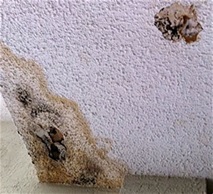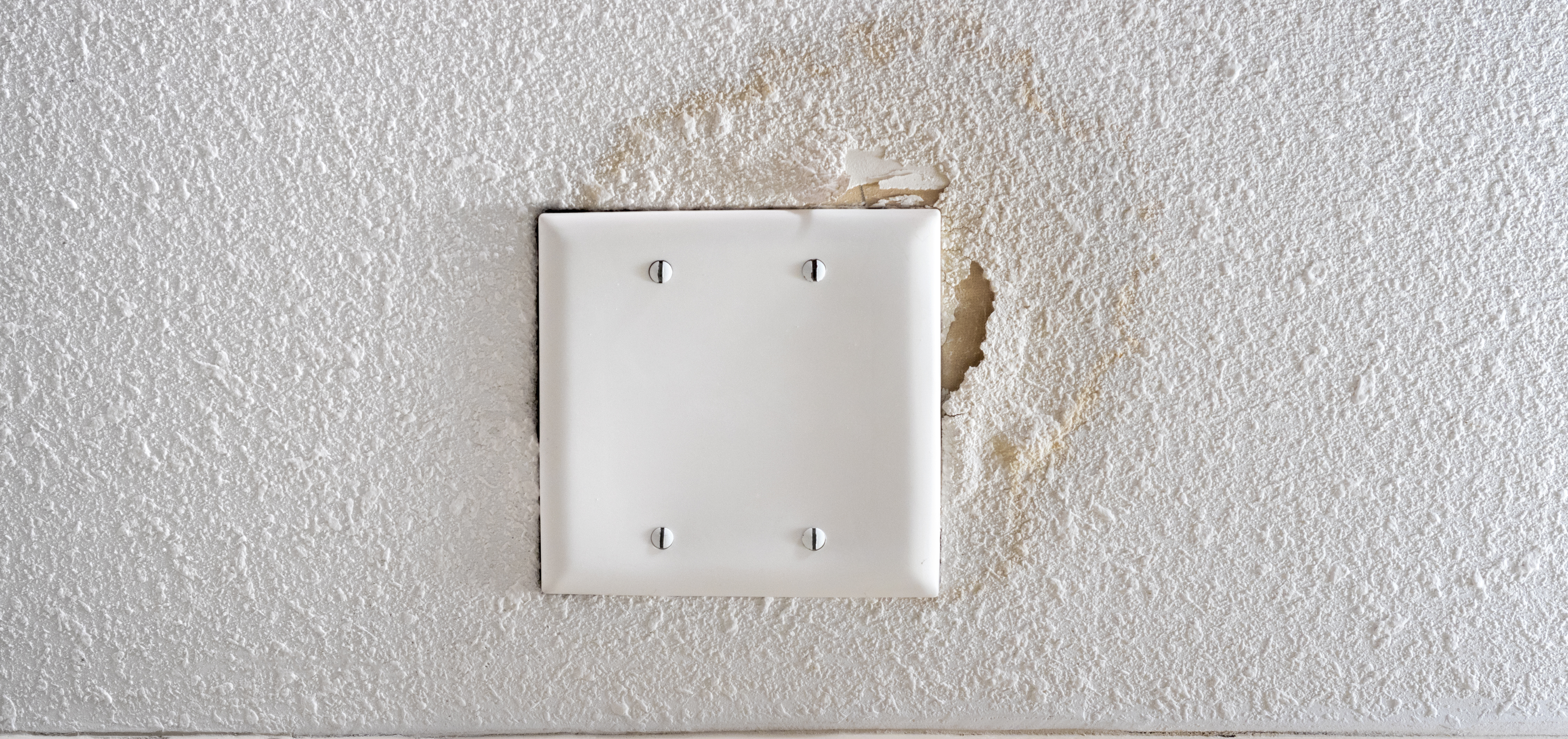Eliminating mold on popcorn ceilings can be a difficult job. A popcorn finish is a bumpy, very uneven texturing that resembles cottage cheese and that was popular during the early 1970’s. The finish was usually sprayed on and was effective at hiding blemishes and seam lines. When new, it was bright white in color and was claimed to have really good acoustical properties.

Today, popcorn ceilings are frowned upon by homeowners and homebuyers because they tend to collect dust and don’t do a very good job of reflecting natural light. Also many popcorn-ceiling finishes contain asbestos. You can still find textured ceilings in newly built homes, but very few popcorn ceilings.
What Is Mold?
- Mold is not dust or dirt.
- You can’t eliminate mold with ordinary cleaning chemicals or detergents.
- You should not attempt to just sweep it or brush it away.
- Despite many “expert’s” advice, chlorine bleach, which is 98% water, should NOT be used in an attempt to remove mold from porous surfaces like popcorn ceilings. The chemical chlorine will not penetrate and the water contained in chlorine bleach will add to the supply of moisture that the mold needs to survive.
- In biblical times people were not instructed to clean mold, they were told to remove it. Times haven’t changed; mold needs to be physically removed.
- What kind of mold is it? It doesn’t really matter, you don’t want to keep it, and you must have it removed.
Mold’s Common Health Dangers
Being exposed to mold and mold spores can cause health problems, including allergic reactions, inflammation of the lungs, pain in the chest, and sinus infections. People with conditions like asthma and emphysema are more susceptible to mold-related illnesses, and so are the very young and the very old. Anyone receiving chemotherapy treatments should avoid any contact with mold. However, anyone can be affected.
If you have health problems you think might be caused by exposure to mold, talk to your doctor. Your doctor can perform allergy tests or other tests in order to make a diagnosis and prescribe the appropriate treatment. In order to fully recover, though, you’ll need to clean up the mold in your home to avoid any further exposure to it.
Removing Mold From Popcorn Ceilings
Before starting any mold removal project, you need to suit up properly to protect yourself. This means donning latex or rubber gloves, eye protection, and a disposable pair of coveralls. A N-95 respirator or facemask should be worn to avoid inhaling and mold spores. Mold spores are easily disbursed when disturbed and will easily become airborne.
Open windows and use a fan if possible to help ventilate the affected rooms. Close any doors into the affected areas and if necessary, set up containment t prevent accidental cross-contamination of unaffected rooms and areas. Seal heat registers and cold air returns with 6-mil plastic and tape (first turn off your furnace or central air conditioning system).
Use an antimicrobial cleaner in a spray bottle or a pump-up garden-like sprayer. Don’t use bleach! There are numerous products that are antimicrobial and they are easy to find at most hardware stores or home improvement stores. If you are sensitive to chemicals, you can use white vinegar.
Spray the cleaning solution onto the ceiling. Allow it to dwell for at least 30-45 minutes. Wipe it away with a clean damp cloth. Never re-dip a used cloth into your clean water, as this will contaminate the water. If you are lucky, very lucky, you will have removed the mold.
Why This May Not Work
Mold has roots and they will grow into and through porous materials like the drywall that is under the popcorn texturing. You may think the mold is gone, only to see it reappear a few days later. All your extensive efforts have been wasted. The mold was growing deeper than just on the surface of the ceiling.
Instead of cleaning mold, or attempting to kill it, mold should be physically removed. In this case, it would mean removing the affected drywall completely. The affected drywall should be cut out and bagged for proper disposal BEFORE it is removed from the area. Because mold removal is a much harder job than it first appears is why you should seek out a professional remediation company when mold is a problem in your home.
Professional mold remediators have the necessary knowledge and tools to deal with any residential mold problems. They understand all of the needed safety procedures, both yours and their own and how to handle mold removal properly the first time.
Staying in Your Home During Mold Remediation
Is the entire home affected? Will you still be able to use the kitchen and one bathroom without passing through any contaminated areas? Or is the mold contained to just one area or room that you can avoid entering or using during the removal process? There are a few things you should consider before you decide to remain in your residence:
- Is the HVAC system affected?
- It’s Going To Get Loud! Will the noise from the contractor’s machinery get on your nerves?
- How extensive is the remediation work that is required?
- Sensitivity issues may be the deciding factor. What type of chemicals, if any, will be used during remediation?
- Reconstruction and repair may also impact a home’s environment.
Mold remediation is serious work that contains serious risks. You need to understand the entire process and what may be involved. And the mold you can see is usually not the only mold present.
We suggest consulting with a mold remediation professional like Water Mold Fire Restoration before attempting to clean, remove, or replace mold on your popcorn ceilings, especially if the mold affects an area greater than 10 square feet. We respond 24/7 and can have IICRC-certified technicians on site in less than one hour. We can be reached by email at help@watermoldfire.net or by calling 800-905-0277. Our initial inspection and consultation is free with no further obligation.








